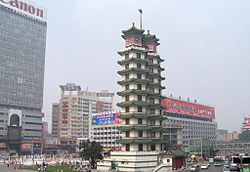The Erqi Memorial Tower, or Erqi Tower (Chinese: 二七纪念塔; pinyin: Èrqī Jìniàntǎ) is located in Erqi District, in the centre of Zhengzhou city, Henan province, China.[1] The tower is 63 meters high and has 14 floors.[1][2] It was historically the tallest building in Zhengzhou until 1976. [3]
| Erqi Memorial Tower | |
|---|---|
二七纪念塔 | |
 | |
 | |
| Alternative names | Erqi Tower |
| General information | |
| Architectural style | Chinese architectural style |
| Town or city | Zhengzhou |
| Country | China |
| Coordinates | 34°45′11″N 113°39′36″E / 34.753°N 113.66°E |
| Completed | September 29, 1971 |
| Height | 63 meters |
| Technical details | |
| Floor count | 14 |
History
editThe current Erqi Memorial Tower was completed on September 29, 1971.[2] It serves as a memorial to the Great Strike of February 7, which occurred on February 7, 1923.[2]
In May 2020, it was announced that the square surrounding the tower would be enlarged to 21,000 square metres (5.2 acres), and that an adjacent building, the Friendship Mansion (Chinese: 友谊大厦; pinyin: Yǒuyì Dàshà), a 20 story building, would be downgraded to 6 stories in height.[1] This plan will be carried out to better highlight the tower.[1]
Description
editThe tower stands in Erqi Square.[1] It is made from reinforced concrete, and is done in a Chinese architectural style.[1] The tower's shape, two pentagonal conjoined towers, is meant to commemorate the striking workers of the Erqi Strike, who went on strike while building the Beijing–Hankou railway.[1][2] At the top of the tower is a five-pointed red star and a 2.7 meter clock below. The clock plays the Chinese revolutionary song The East Is Red every hour.[1] The tower displays various historical relics, pictures, and written materials about the strike.[1]
Notes
edit- ^ a b c d e f g h i Zhong, Yuhao (2020-05-17). 为突显郑州二七塔庄严肃穆,周边一20层大厦6层以上将拆除. The Paper (in Chinese). Archived from the original on 2020-12-27. Retrieved 2020-12-26.
- ^ a b c d 河南“二七”纪念塔(图). China Internet Information Center (in Chinese). 2002-04-18. Archived from the original on 2006-06-22. Retrieved 2020-12-26.
- ^ 郑州最高建筑的百年变迁 (in Chinese).